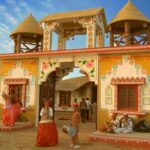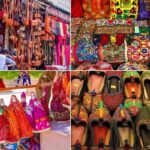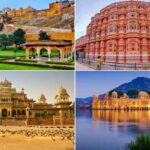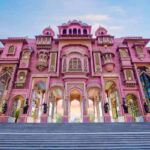The Rich Culture of Rajasthan, a state in northern India, is renowned for its vibrant cultural heritage. It boasts majestic forts and palaces such as Amber Fort and Mehrangarh Fort, reflecting the grandeur of Rajputana architecture. The state’s traditional arts and crafts, like Bandhani textiles and blue pottery, are world-famous, along with intricate jewelry styles like Kundan and Meenakari.
Rajasthan‘s folk music, featuring instruments like the sarangi and dholak, and dances such as Ghoomar and Kalbeliya, are integral to its cultural identity. The cuisine, known for its rich flavors and spices, includes dishes like Dal Baati Churma and Laal Maas, with sweets like Ghewar and Mawa Kachori.
Colorful festivals like the Pushkar Camel Fair and Teej showcase the state’s celebratory spirit. Traditional attire, characterized by vibrant colors and intricate designs, includes men’s turbans and women’s ghagras and odhnis. Rajasthani, along with its various dialects, enriches the linguistic landscape, while numerous temples and pilgrimage sites highlight the region’s spiritual depth. Overall, Rajasthan’s culture is a captivating blend of history, art, and tradition, Rajasthan Tour Planner.

History of Rajasthan
Rajasthan, a state in northern India, has a rich and diverse history dating back to ancient times. The region was part of the Indus Valley Civilization, one of the world’s earliest urban cultures. Over centuries, Rajasthan became a mosaic of princely states ruled by Rajput clans, who were known for their warrior ethos and chivalry.
During the medieval period, Rajasthan saw the rise of powerful kingdoms such as Mewar, Marwar, and Jaipur. The Rajputs built magnificent forts and palaces, exemplifying their architectural prowess. Notable structures include Chittorgarh Fort, Kumbhalgarh Fort, and the City Palace in Udaipur. The Rajputs fiercely defended their territories against various invaders, including the Delhi Sultanate and the Mughal Empire. Despite intermittent conflicts, many Rajput rulers formed strategic alliances with the Mughals, leading to a period of relative peace and prosperity.
The British colonial era brought significant changes to Rajasthan. The region, then known as Rajputana, was a collection of princely states that maintained semi-autonomous status under British suzerainty. The Rajput rulers retained their titles and privileges but had to recognize British authority, The Rich Culture of Rajasthan.
Post-independence, Rajasthan underwent political reorganization. In 1949, the princely states were merged to form the modern state of Rajasthan. Jaipur was designated the state capital. Since then, Rajasthan has developed significantly, balancing the preservation of its rich heritage with modernization efforts.
Today, Rajasthan is celebrated for its vibrant culture, historical monuments, and contributions to Indian history. Its legacy of valor, art, and architecture continues to attract scholars, tourists, and heritage enthusiasts from around the world.

Festivals of Rajasthan
Rajasthan is renowned for its colorful and vibrant festivals, which showcase the state’s rich cultural heritage and traditions. Here are some of the most prominent festivals celebrated in Rajasthan:
Pushkar Camel Fair: Held annually in the town of Pushkar, this week-long fair is one of the largest camel fairs in the world. It features camel trading, cultural performances, camel races, and religious rituals. The fair coincides with the Kartik Purnima festival, attracting thousands of tourists and pilgrims.
Teej: Celebrated during the monsoon season, Teej is dedicated to the goddess Parvati and commemorates her reunion with Lord Shiva. Women dress in colorful traditional attire, fast for the well-being of their husbands, and participate in processions, folk dances, and swings adorned with flowers.
Gangaur: This festival honors Goddess Gauri (Parvati) and is celebrated with great fervor by married women seeking marital bliss and longevity for their husbands. Women carry clay pots adorned with colorful decorations and walk in processions, singing traditional songs.
Marwar Festival: Held in Jodhpur, the Marwar Festival celebrates the music, dance, and cultural heritage of the Marwar region. It features folk performances, camel tattooing, polo matches, and exhibitions showcasing local art and crafts.
Teej and Gangaur Fair: This joint celebration in Jaipur combines the festivities of Teej and Gangaur. It includes processions, cultural performances, traditional rituals, and a vibrant fair with handicraft stalls, food vendors, and amusement rides.
Desert Festival: Celebrated in Jaisalmer, the Desert Festival showcases the cultural richness of Rajasthan’s desert region. It features folk music and dance performances, camel races, turban tying competitions, and stalls selling local handicrafts and cuisine, The Rich Culture of Rajasthan.
These festivals offer visitors a glimpse into Rajasthan’s colorful traditions, vibrant culture, and warm hospitality, making them an integral part of the state’s cultural identity.
Rajasthan Languages and Dialects
Rajasthan is a linguistically diverse state, home to several languages and dialects. The primary language spoken in Rajasthan is Rajasthani, which itself has several distinct dialects. Here are some of the key languages and dialects spoken in the state:
Rajasthani: Rajasthani is the most widely spoken language in Rajasthan and is considered the state’s principal language. It is part of the Western Indo-Aryan language group and has numerous dialects, including Marwari, Mewari, Dhundhari, Shekhawati, and Harauti. Each dialect has its unique characteristics and variations.
Hindi: Hindi is the official language of Rajasthan and serves as a lingua franca for communication across the state. It is widely understood and spoken, particularly in urban areas and among educated populations.
Urdu: Urdu, an Indo-Aryan language with significant Persian and Arabic influences, is spoken by a minority of people in Rajasthan, primarily in urban centers and among the Muslim community.
Sindhi: Sindhi, an Indo-Aryan language with roots in the historical region of Sindh (now in Pakistan), is spoken by the Sindhi community in Rajasthan, particularly in cities like Jodhpur and Jaipur.
Gujarati: Gujarati, another Indo-Aryan language, is spoken by the Gujarati community in Rajasthan, especially in areas bordering Gujarat.
Punjabi: Punjabi, an Indo-Aryan language primarily spoken in the Indian state of Punjab, is spoken by a small community in Rajasthan, particularly in cities like Bikaner and Sri Ganganagar.
English: With the increasing importance of education and commerce, English has become widely used in urban areas, especially among the younger generation and in professional settings.
These languages and dialects contribute to the linguistic diversity of Rajasthan, reflecting the state’s rich cultural heritage and historical connections with various regions and communities, The Rich Culture of Rajasthan.

Rajasthan Music and Dance
Rajasthan is renowned for its vibrant music and dance forms, which are integral to its cultural identity. Here are some of the key music and dance traditions of Rajasthan:
Folk Music: Rajasthani folk music is characterized by its soulful melodies, rhythmic beats, and poignant lyrics. Instruments like the dholak, sarangi, khartal, and morchang (Jew’s harp) are commonly used. Songs often narrate tales of love, valor, and devotion, reflecting the region’s rich history and traditions.
Ghoomar: Ghoomar is one of the most popular traditional dances of Rajasthan, performed by women during festive occasions. It involves graceful circular movements, accompanied by synchronized clapping and traditional folk songs. The dance is known for its colorful attire, particularly the flowing ghagra (skirt) and odhani (scarf).
Kalbeliya: Originating from the Kalbeliya community, this dynamic dance form is performed by women who dance with graceful movements, often replicating the movements of serpents. It is accompanied by traditional folk songs and the distinctive rhythm of the dholak and been (snake-charmer’s flute).
Bhavai: Bhavai is a traditional folk dance-drama that originated in Rajasthan. Performers balance multiple pots on their heads while executing acrobatic movements, showcasing their skill and agility. The dance often portrays stories from mythology, folklore, and everyday life.
Kathputli (Puppet) Dance: Rajasthan is famous for its puppetry traditions, and the Kathputli dance involves performers manipulating colorful puppets to the rhythm of traditional folk music. The puppeteers skillfully animate the puppets, creating captivating performances that often convey moral lessons or entertain audiences with humorous anecdotes.
Chari Dance: This traditional folk dance is performed by women who balance brass pots (charis) on their heads while dancing. The dance originated in the desert regions of Rajasthan and is often accompanied by folk songs that celebrate the spirit of womanhood and community.
Fire Dance: Fire dance is a mesmerizing yet perilous folk dance form performed by the Jasnathi tribe of Rajasthan. Performers dance on beds of burning coals or flaming torches, displaying their courage and spiritual devotion, The Rich Culture of Rajasthan.
These music and dance forms of Rajasthan reflect the state’s vibrant cultural heritage, captivating audiences with their rhythmic beats, colorful attire, and expressive storytelling.

Rajasthan Cuisine – The Rich Culture of Rajasthan
Rajasthani cuisine is renowned for its rich flavors, aromatic spices, and hearty dishes. Influenced by the region’s arid climate and warrior lifestyle, Rajasthani cuisine features a variety of vegetarian and non-vegetarian dishes that are both flavorful and nutritious. Here are some iconic dishes of Rajasthan:
Dal Baati Churma: This quintessential Rajasthani dish consists of baked dough balls (baati) served with a mix of lentils (dal) and a sweet crumbled mixture of wheat, sugar, and ghee (churma). It’s often accompanied by tangy mango or garlic chutney.
Laal Maas: Laal Maas is a fiery red meat curry made with mutton or lamb, flavored with a blend of spices including red chili powder, garlic, and yogurt. The dish gets its vibrant color and intense flavor from the use of Mathania red chilies.
Gatte ki Sabzi: This popular vegetarian dish features gram flour (besan) dumplings (gatte) cooked in a spicy yogurt-based gravy. It’s flavored with a variety of spices such as cumin, coriander, and asafoetida.
Ker Sangri: Ker Sangri is a traditional Rajasthani dish made with desert beans (sangri) and berries (ker) cooked in a tangy and spicy gravy. It’s often served as a side dish with bread or rice.
Bajre ki Roti: Bajre ki Roti is a staple flatbread made from pearl millet flour (bajra). It’s a nutritious and gluten-free alternative to wheat roti and is commonly enjoyed with ghee, curries, or chutneys.
Mirchi Vada: Mirchi Vada is a popular street food snack from Rajasthan, consisting of large green chilies stuffed with spicy potato filling, coated in gram flour batter, and deep-fried until crispy and golden brown.
Ghewar: Ghewar is a traditional Rajasthani dessert made during festivals and special occasions. It’s a deep-fried disc-shaped sweet made from flour and soaked in sugar syrup, often garnished with nuts and edible silver foil.
Mawa Kachori: Mawa Kachori is a sweet delicacy from Rajasthan made with deep-fried pastry stuffed with a rich mixture of sweetened khoya (mawa), nuts, and cardamom. It’s usually served as a dessert or snack.
These are just a few examples of the diverse and flavorful cuisine that Rajasthan has to offer. Whether you’re craving spicy curries, hearty breads, or indulgent sweets, Rajasthani cuisine has something to satisfy every palate, The Rich Culture of Rajasthan.

Rajasthani Traditional Dress
Rajasthani traditional attire is known for its vibrant colors, intricate designs, and cultural significance. Both men and women wear clothing that reflects the region’s rich heritage and desert climate. Here’s a glimpse into the traditional dress of Rajasthan:
Men’s Traditional Dress:
Pagri (Turban): The turban is an integral part of men’s attire in Rajasthan. It’s often made from colorful cotton or silk fabric and tied in various styles, each carrying its own significance, indicating the wearer’s caste, region, or social status The Rich Culture of Rajasthan.
Dhoti or Pajama: Men typically wear a dhoti, a long rectangular piece of cloth wrapped around the waist and legs, or pajama, loose-fitting trousers, as the lower garment. These are often paired with a matching or contrasting kurta (long shirt) or angarkha (tunic).
Safa: Safa is a type of turban worn during special occasions and ceremonies. It’s larger and more intricately tied than the everyday pagri, often adorned with embellishments like jewels, brooches, or decorative pins.
Women’s Traditional Dress:
Ghagra or Lehenga: Women in Rajasthan wear ghagras, long skirts made from colorful fabrics such as silk, cotton, or chiffon. These skirts are often heavily embellished with embroidery, mirror work, and intricate designs.
Choli: The choli is a fitted blouse or bodice worn with the ghagra. It’s usually cropped, leaving the midriff exposed, and is often embellished to match the skirt.
Odhnis or Dupattas: Women drape a long scarf or odhni over their head or shoulders, complementing their attire. Odhnis are often adorned with embroidery, mirror work, and tassels, adding to their beauty.
Jewelry: Rajasthani women adorn themselves with an array of traditional jewelry, including necklaces, earrings, bangles, and anklets. Pieces are often crafted from gold, silver, or brass and feature intricate designs and colorful gemstones.
Bangles and Bindis: Glass bangles and decorative bindis (forehead stickers) are commonly worn as accessories, adding to the overall elegance of the attire, The Rich Culture of Rajasthan.
Rajasthani traditional dress reflects the region’s vibrant culture, with its bold colors, intricate designs, and symbolic elements. Whether worn during festivals, weddings, or everyday life, these garments are a proud expression of Rajasthan’s rich heritage.








